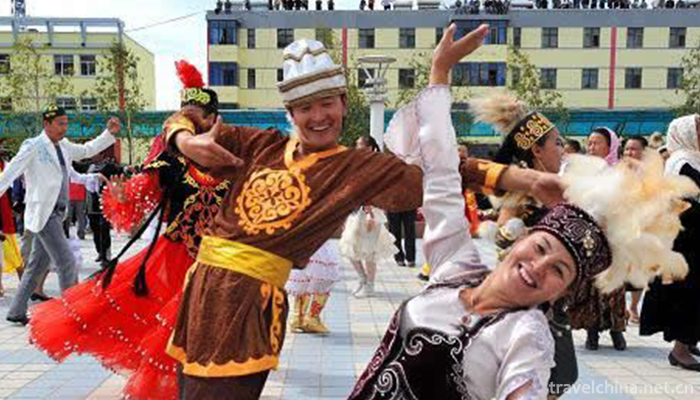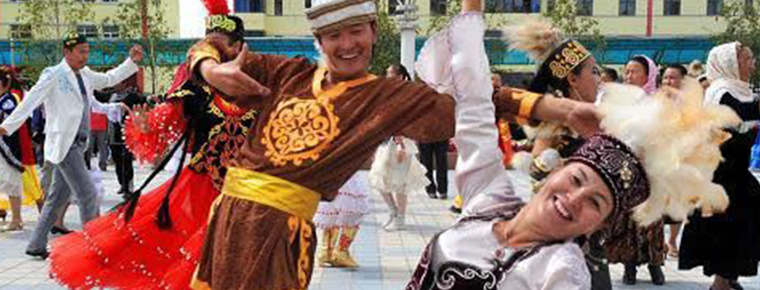Kazakh Karakol Leha
Kazakh Karakol Leha
Kazakh Kara Kolkha is a traditional dance of Kazakh nationality, which is spread in Yili, Xinjiang.
On May 23, 2011, Kazakh Karakol Kazakh was listed in the third batch of national intangible cultural heritage list with the approval of the State Council.
Legends of origin
Kalakolha is an ancient dance, about its origin, there is a legend in the Kazakh people: long ago, there was a Kazakh young man on the grassland, found a group of wild horses, he waved a rope to tie a very tough black wild horse. The young man went through all kinds of hardships and finally domesticated it into a good walking horse. When he returned home on a black horse, the villagers came to congratulate him on the news. The delighted young man danced and proudly and humorously simulated the whole process of capturing and domesticating the black horse with various movements. His vivid description and vivid performance made the villagers fascinated. Everyone listened to the young man's wonderful story and imitated his various movements of dancing and dancing. People immersed in joy danced and danced like this. Unconsciously, the people of the whole town jumped up with their own different dancing postures, imitating the action of the black horse. From then on, the Kazakh folk dance, which takes horse riding as the theme and expresses the vigorous posture of the steed galloping on the grassland, has spread.
Introduction to nouns
"Kazakh" is a Kazakh language, meaning "black walking horse". It was originally a simple body dance used by Kazakhs to imitate the walking, running and jumping postures of horses. It gradually evolved into a synonym of Kazakh folk dance. Performers often blend various movements with strong characteristics of labor and life into dance, making the dance content of "Kazakh" more abundant. Rich and diverse.
Style and characteristics
Karakol Leha: It is the most representative folk dance of the Kazakh people. Kazakh is Kazakh, meaning "black horse". The horse is an indispensable tool and partner in Kazakh life, and the "black walking horse" is the most important thing in the horse. It has a strong image, a bright black body, a steady and powerful walking pace, a graceful posture, and the sound of hoofs is like a clang drum. Riding on a black walking horse is like entering an artistic realm. People are dancing while horses are dancing. The male's movements imitate the walking, running, jumping and jumping postures of the black walking horse, and display a rugged, bold and bold style in a relaxed rhythm of the whole body. Women's movements are graceful, stretching, lively and implicit, such as showing the beauty and pride of the girl's "flower praise", peeping at the lover's "shy peep", looking forward and backward "skirt hanging flowers" and so on. These movements of men and women contain specific contents, which are integrated with the performer's inner feelings and humorous facial expressions, and can be freely developed according to the dancer's own level, constantly adding new contents and actions. Caracolla Leha is accompanied by music of the same name. This kind of music has a strong sense of rhythm, lively and lively, and its melody is like a steed galloping on the grassland. It is played by Dongbula, a traditional instrument of Kazakh nationality, and changes its rhythm according to the speed of dance.
Protection status
Since 1986, Kazakh Karakol Leha has been paid attention by professional groups, and its dance movements and music have been further improved. With the gradual implementation of the national policy for the protection of intangible cultural heritage, a project to excavate and protect the original ecological intangible cultural heritage is also in full swing throughout the state. Kazakh dance in Ili, which has a deep historical origin, cultural accumulation and broad mass base, has attracted the attention of the state, government departments at all levels and the public. "Black Walking Horse" was summoned from the quiet and remote mountains, and entered the vision of the broad audience, becoming a cultural wonder that integrates artistry and popularity.
On May 23, 2011, Kazakh Karakol Kazakh was listed in the third batch of national intangible cultural heritage list with the approval of the State Council.
Influence
In 2010, Karakol Leha entered the third batch of National Intangible Cultural Heritage Representative works. For a time, there was a rising "black-horse" fever in the urban and rural areas of Yili. Whether in the vast grassland with green grass, or in the plaza with laughter and laughter, or in the campus where the students seek knowledge and study, we can see the "black walking horse" dance posture which is light, vigorous, vigorous, graceful, stretching, lively and implicit. On August 30, 2009, 10,000 people danced together in Qinghe County, which set a world record of Guinness in Shanghai. In order to continue to carry forward Kazakh, a traditional fine folk art, and further strengthen the protection of intangible cultural heritage, Qinghe County decided to designate August 30 as the Kazakh "Kala Kok Leha Festival".
In order to carry out "student sunshine sports" extensively and ensure that students exercise for one hour every day, the education system of Xinyuan County takes Kara Korlaha as a highlight of school art education. During the big classes, students of all ethnic groups danced with the happy and smooth instrumental music and the bright melody of Kazakh. The huge lineup, magnificent momentum, exquisite dancing skills and graceful dancing postures make the rough, drastic, robust and bold style of the "black walking horse" vivid, vivid, incisive and shocking.
On January 26, the Autonomous Prefecture held a seminar in Calagorah. At the meeting, seven experts read out relevant papers, and the paper "Dance of History 2000" read by Asen Kumar of the Xinjiang Academy of Social Sciences aroused great repercussions. The old experts, such as Karimu Abdurehman, put forward their own views on the current situation and existing problems of Kazakh dance development, and appealed to everyone to excavate Kazakh folk dance represented by Kazakh Kolkha, absorb nutrients from the folk, create dances that accord with Kazakh people's aesthetic habits and life interests, and further enrich the dance vocabulary of Kazakh Kolkha. Music and lyrics.


-
1.Alipay
Alipay (China) Network Technology Co., Ltd. is the third party payment platform in China. It is committed to providing a simple, safe and fast payment solution
Time 2018-11-13 -
2.Zhenjiang Sanshan Scenic Area
Zhenjiang Sanshan Scenic Area is located in the southwest of Jiangsu Province and on the South Bank of the lower reaches of the Yangtze River
Time 2018-12-06 -
3.Wenchuan Special Tourist Area
Wenchuan Special Tourist Area is a memorial and cultural theme scenic area specially developed after the reconstruction of the Wenchuan Earthquake on May 12, 2008
Time 2018-12-12 -
4.Qianfoya Scenic Spot
Guangyuan Qianfoya is the largest grotto group in Sichuan Province. The statues of cliffs began in the Northern Wei Dynasty. After nearly 1500 years, the cliffs, which are 45 meters high and 200 meter
Time 2018-12-26 -
5.Manufacturing Techniques of Tussah Paper
The manufacturing history of tussah paper is as long as that of linen paper. The raw material for making the paper is the phloem fibers of the tree. The bark of the tree contains wood phloem fibers wh
Time 2019-04-18 -
6.Black Tea Production Techniques
Black tea, originally known as "Border Tea", was smuggled across the border by merchants as early as the end of the 16th century. In the Ming Dynasty, black tea was designated as
Time 2019-05-03 -
7.The Craft of Juchunyuan Buddha Jumping Wall
"Buddha Jumping Wall" is the first famous dish in Fujian cuisine. It is well-known at home and abroad for its exquisite materials, unique preparation method and strong flavor
Time 2019-05-08 -
8.Wooden drum dance
Wood drum dance is a kind of folk dance that is spread among the Miao, Yi and Wa people in southwest China to dance and sacrifice by beating wood drum. Its drum shape is mostly to intercept the trunk
Time 2019-06-06 -
9.Legend of King Qian
The legend of King Qian is a local folklore derived from the life stories of King Qian Si of Wuyue. Linan is the hometown of King Qian. After his death, his legends have been widely circulated in Lina
Time 2019-06-10 -
10.Qin opera
Qin Opera, also known as Bangzi Opera, is a traditional drama in Northwest China and one of the national intangible cultural heritage.
Time 2019-06-10 -
11.She Costume
She nationality's men and women's clothing is basically the same as that of the local Han people. However, the She ethnic costumes in Fujian and Zhejiang provinces with relatively concentrated populat
Time 2019-06-14 -
12.Yi Folk Songs
Yi folk song is an important carrier of Yi culture and one of the most important forms of inheriting Yi culture. It records the history, science, production and life, traditional customs, philosophy,
Time 2019-07-12